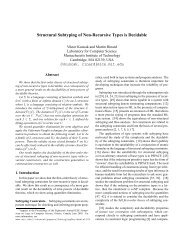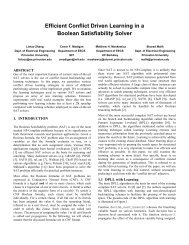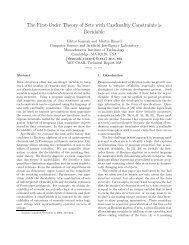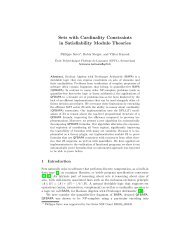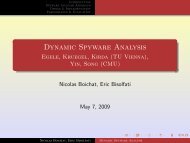Classifying and Solving Horn Clauses for Verification - Lab for ...
Classifying and Solving Horn Clauses for Verification - Lab for ...
Classifying and Solving Horn Clauses for Verification - Lab for ...
Create successful ePaper yourself
Turn your PDF publications into a flip-book with our unique Google optimized e-Paper software.
<strong>Classifying</strong> <strong>and</strong> <strong>Solving</strong> <strong>Horn</strong> <strong>Clauses</strong> <strong>for</strong> <strong>Verification</strong> 5clauses are usually extracted from recursive clauses by means of finite unwinding; examplesare given in Sect. 5.3 <strong>and</strong> 5.5.4 Formulae <strong>and</strong> <strong>Horn</strong> <strong>Clauses</strong>Constraint languages. Throughout this paper, we assume that a first-order vocabularyof interpreted symbols has been fixed, consisting of a set F of fixed-arity functionsymbols, <strong>and</strong> a set P of fixed-arity predicate symbols. Interpretation of F <strong>and</strong> P isdetermined by a class S of structures (U, I) consisting of non-empty universe U, <strong>and</strong>a mapping I that assigns to each function in F a set-theoretic function over U, <strong>and</strong>to each predicate in P a set-theoretic relation over U. As a convention, we assumethe presence of an equation symbol “=” in P, with the usual interpretation. Given acountably infinite set X of variables, a constraint language is a set Constr of firstorder<strong>for</strong>mulae over F , P, X For example, the language of quantifier-free Presburgerarithmetic has F = {+, −, 0, 1, 2, . . .} <strong>and</strong> P = {=, ≤, |}).A constraint is called satisfiable if it holds <strong>for</strong> some structure in S <strong>and</strong> some assignmentof the variables X, otherwise unsatisfiable. We say that a set Γ ⊆ Constr ofconstraints entails a constraint φ ∈ Constr if every structure <strong>and</strong> variable assignmentthat satisfies all constraints in Γ also satisfies φ; this is denoted by Γ |= φ.fv(φ) denotes the set of free variables in constraint φ. We write φ[x 1 , . . . , x n ] to statethat a constraint contains (only) the free variables x 1 , . . . , x n , <strong>and</strong> φ[t 1 , . . . , t n ] <strong>for</strong> theresult of substituting the terms t 1 , . . . , t n <strong>for</strong> x 1 , . . . , x n . Given a constraint φ containingthe free variables x 1 , . . . , x n , we write Cl ∀ (φ) <strong>for</strong> the universal closure ∀x 1 , . . . , x n .φ.Craig interpolation is the main technique used to construct <strong>and</strong> refine abstractions insoftware model checking. A binary interpolation problem is a conjunction A ∧ B ofconstraints. A Craig interpolant is a constraint I such that A |= I <strong>and</strong> B |= ¬I, <strong>and</strong>such that fv(I) ⊆ fv(A) ∩ fv(B). The existence of an interpolant implies that A ∧ B isunsatisfiable. We say that a constraint language has the interpolation property if alsothe opposite holds: whenever A ∧ B is unsatisfiable, there is an interpolant I.4.1 <strong>Horn</strong> <strong>Clauses</strong>To define the concept of <strong>Horn</strong> clauses, we fix a set R of uninterpreted fixed-arity relationsymbols, disjoint from P <strong>and</strong> F . A <strong>Horn</strong> clause is a <strong>for</strong>mula C ∧ B 1 ∧ · · · ∧ B n → Hwhere– C is a constraint over F , P, X;– each B i is an application p(t 1 , . . . , t k ) of a relation symbol p ∈ R to first-order termsover F , X;– H is similarly either an application p(t 1 , . . . , t k ) of p ∈ R to first-order terms, or isthe constraint false.H is called the head of the clause, C∧B 1 ∧· · ·∧B n the body. In case C = true, we usuallyleave out C <strong>and</strong> just write B 1 ∧ · · · ∧ B n → H. First-order variables (from X) in a clauseare considered implicitly universally quantified; relation symbols represent set-theoretic



